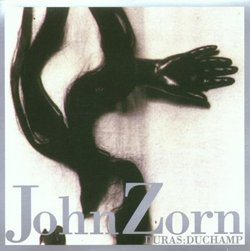| All Artists: John Zorn, John Medesky, Anthony Coleman Title: Duras: Duchamp Members Wishing: 3 Total Copies: 0 Label: Tzadik Release Date: 8/19/1997 Genres: Jazz, Special Interest, Classical Styles: Avant Garde & Free Jazz, Historical Periods, Modern, 20th, & 21st Century Number of Discs: 1 SwapaCD Credits: 1 UPC: 702397702320 |
Search - John Zorn, John Medesky, Anthony Coleman :: Duras: Duchamp
 | John Zorn, John Medesky, Anthony Coleman Duras: Duchamp Genres: Jazz, Special Interest, Classical
|
Larger Image |
CD DetailsSimilar CDs
|
CD ReviewsSurrealistic Nightmare Music Christopher Forbes | Brooklyn,, NY | 01/30/2003 (5 out of 5 stars) "John Zorn has made a career out of stylistic diversity. His musical intellect is mecurial and cannot be kept within a few projects or styles, but instead jumps around from style to style and records the results obsessively. This can make pinning him down dearly impossible, but makes each new release you hear an adventure. Duras/Duchamp falls into the broad genre of studio compositions. Zorn's studio compositions are often an interesting mix of chamber music sensibility, electronic effects, collage techniques, and improvisations which often sound as if they were the soundtrack to some imaginary film. In this way they can be similar to Zorn's actual film work. But they are more formally composed than Zorn's film music, with less reliance on cartoon music montage and more sustained moods. As such I find the studio pieces to be among Zorn's most polished and satisfying work. The long work on this disc is Duras. Named for the engimatic novelist (was she a heroine of the French resistance or a Nazi collaborator? The world may never know for sure.) who's most famous book The Lover, is one of the most disturbing erotic novels in history, Duras is a multimovement work. It generates most of it's effect through rather traditional means. But for a few "found sounds" on tape, the work could be a concert hall piece. It stays at a low level throughout, giving it some relation to ambient music, but it's details are much more interesting. It is not a loop piece, but genuinely through composed and compelling. Duchamp is a bit more dadaist in conception. Much of the work could be described as Satie run through a distorting mirror as heard by a guy on a bad acid trip. If this sounds weird, it is. And that's what makes it compelling listening. Zorn rarely goes for a listeners comfort level and this piece pleases and disturbs in equal measure. I've listened to this disc now several times and the work on it grow more compelling with each hearing. This is definately one of Zorn's high water marks." Two tributes SPM | Eugene, Oregon | 10/28/2003 (4 out of 5 stars) "Although this album has five tracks, it has only two songs. The first song, dedicated to M. Duras, is played in four movements (and indexed that way on the CD). The movements come in pairs: a long one followed by a brief coda, then another long one with a coda. The music flows so well that you don't notice these little details. The piece is played with piano, light percussion, and strings. The musicians play subtle, gentle sounds. You'll hear a little melody, then some drumming, and then the sound of birds chirping in the background. Then a violin quietly comes in . . . and drifts away. One sound fades as another begins. This is one of John Zorn's most enigmatic ambient compositions. If you hear it twice, you'll be hooked.The final track is a 13-minute tribute to M. Duchamp. For this "song," Zorn "plays" all kinds of objects. He smacks blocks of wood together, pounds a nail, drops coins into a dish, etc. He even gurgles into a mug and then coughs. This might sound kind of stupid, but it actually works in a weird way. It's not music, but it does feel *composed*.I recommend this album to anyone who enjoys avant-garde classical music, and anyone who wants to explore John Zorn's non-jazz, non-noise music. If you're in an adventurous mood and have a good sense of humor, you'll like it."
|

 Track Listings (5) - Disc #1
Track Listings (5) - Disc #1

